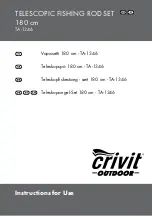
5
• RISK OF INJURY!
Risk of injury and accidents!
Test the fishing rod for damage each time before use. never use a
damaged fishing rod; if you do, it may not function properly and may, as a result, not be safe.
Risk of injury and accidents!
This product contains sharp hooks which can cause considerable
injury to the user or other persons. Therefore use the fishing rod withdue caution.
• pay due regardto other anglers (and any other people) and keep a safe distance. some risk of
injury exists from the hook snapping back/sideways in an unpredictable direction when casting the
line if this is not done properly.
• To prevent hook injuries, wear the appropriate glasses and protective headgear.
• do not carry out repairs yourself. consult the service department.
• Keep the fishing rod out of reach of children.
• only allow children to use the fishing rod under the instruction and supervision of an adult.
• WARNINGS: FISh FOOD SlINGShOT
The fish food slingshot (
fig. 5
) included in this fishing set is only suitable for fishing. Attractants, in the
form of fishing bait, such as e.g. canned sweet corn (
fig. 6
) or maggots (
fig. 7
), can be placed in the
area of fishing in order to create a feeding ground within the water. caution! Before using the bait,
make sure that there are no persons or animals in the direction of throwing, which could be injured.
The fish food slingshot is not a toy and is not suitable for children under 14 years.
Keep this item out of children’s reach!
Use
Before Using
Caution:
Before fishing, enquire about national laws and local regulations. These instructions give the
general directions for using the product. The sport of angling is well-developed, with many aspects.
We therefore recommend reading appropriate specialized literature and / or seeking advice from
clubs and associations.
how To Assemble The Rod
1. place the reel in the reel mounting 2. Attach it by tightening the mounting screw 1 clockwise.
2. set the reel 6 in the desired position by releasing the opposite screw 5 by turning it anti-clockwise
and tightening it again after it has reached the corresponding position.
3. Release the line reel brake 7 by turning it anti-clockwise. pull the fishing line 10 from the reel 4 and
feed it through all the rings on the rod below the line clamp 3. Tighten the line reel brake 7 once
more by turning it clockwise.
4. Attach the float, leads and line locks to the main line as shown in
fig. 2
and attach a swivel with a
knot (
fig. 3
) in the end. complete with the rig hook which is hooked to the swivel by the loop.
This must be closed again after hooking in! There should always be enough leads mounted to
the main line beneath the float for it to carry them in the water and be well visible for the fisher.
5. extract the rod segment by segment, starting at the top. Also see
fig. 4
. never cast in order to
extract the segments.




















